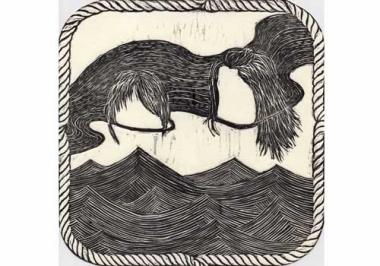Most of us would find it surprising for a bicyclist to approach and hand us a tube full of rolled-up artwork. The world we've made for ourselves, even here in the Valley, doesn't readily accommodate such selfless acts of aesthetic abandon.
How much stranger, then, to know this idea comes from a city that embodies so many contradictions, Berlin? In a country where "das ist verboten" is uttered with the same approximate frequency as "Guten Morgen, Fraulein Scharffenberger," it seems likely that an exceptional case of frisson might result from such generous acts of bicycling. Yet the sprawling city of the Brandenberg Gate and the Kurf?rstendamm is home to lively activity in the street art department. Even that gruesome edifice the Berlin Wall ended up overflowing with bright graffiti on its western side.
Papergirl is a project that began in Berlin in 2006. Right now, its fourth incarnation is underway with a large group of artworks on exhibit for later bike distribution. A small group spearheads the effort, collecting art from submitters all over the globe.
Among those participating in the current Papergirl Berlin you'll find local artist Laura Holland (who often writes about art for Preview magazine). In a recent conversation, Holland explained what will happen when the exhibition (viewable online at www.papergirl-berlin.de) comes to an end later this month.
"The real main event is the distribution," says Holland. "The people who do the distributing—friends, family and sympathizers—are called 'curators.' All of the artworks are rolled up in cylinders. They aim for five to 15 pieces of work in each roll. They have these cylinders on the back of their bicycles, and everybody has a Papergirl flag. Berlin has a lot of bike trails, so the curators gather, get their works and bicycle around and look for people to toss these cylinders of work to."
And just like that, recipients gain a small collection of original artworks.
The Berlin project caught the eye of Eben Kling, an artist who recently moved to the Northampton area. He pointed it out to his former classmates from Montserrat College of Art in Beverly, Katherine Romansky and Adam Kology, who also recently moved to Northampton. Thanks to their efforts, Papergirl Northampton joins the roster of international versions of the project (which also include Papergirl Albany and the California-based Papergirl USA). Artworks will be displayed in Northampton stores and restaurants, then distributed on Sept. 12.
Holland brings up the project's major sticking point, which, she reports, has made the effort somewhat controversial in Germany. "Artists have to be really willing to literally throw their works away. It's a perfect metaphor for art or life."
It is easy to see why that might not appeal to every artist—the maddening reality of being an artist of any kind in America is that too many people consider artistic endeavors a harmless "hobby," something to be done for love. Money only seems to enter the equation when some official imprimatur elevates one's efforts to the "real world" of commercial interactions.
And yet, in the interest of putting art into the hands of those who might never consider dropping into a local gallery or buying one-of-a-kind works, Papergirl seems like a very good thing. There's a certain appeal to sending art out into the world to meet an uncertain fate. Sure, it might end up in a dumpster, but it might provide the centerpiece of some stranger's living room, too.
Artists who wish to submit works for Papergirl Northampton can drop the organizers a line at papergirlnorthampton@gmail.com or visit the website at www.papergirlnorthampton.com. The deadline for submissions is Aug. 20.



